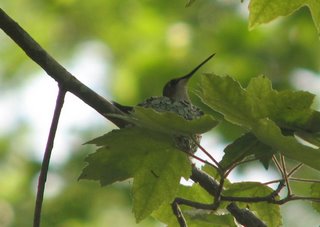


We are seeing young’uns everywhere! In the backyard, the Downy Woodpeckers, the Cardinals, Mockers, Brown Thrashers, Crows, and the Chickadees are all bringing their babies to the yard and showing them the ropes. But today I got a special treat! I work in a 12 story building in downtown
After work I went by City Park/Univ lakes to try out my new scope. Not much to see at a distance, but I did get a very close look at a trio of Juvenile Green Herons. They were along the lake bank, almost in the duck and pigeon congregation. When they saw me looking, they beat it for the safety of a cypress tree. No parents in sight. I’ll go back tomorrow to try to get pictures. They were not quite adult size and still in juvie plumage – but obviously could fly a bit to get off the ground to get into the tree. I sought out one of the Green Heron nests to see how things were coming there. This one is in the “cove” near the gazebo with the scalloped bridge. The nest is under a cypress and not easy to see from shore, but I could make out 3 fuzzy, wobbly heads in the nest there too! Tomorrow I’ll check the other nest near
What fun!


